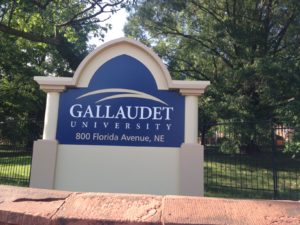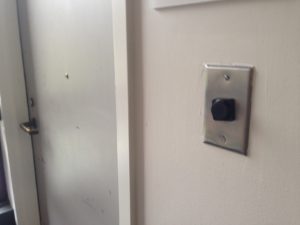 I arrived at Gallaudet University at about 7pm yesterday, after a long 2-day drive from South Bend. As I drove through the gates of the university, I was greeted by banners that said, “Gallaudet University – There is No Other Place Like This in the World.” I must admit feeling a little nervous as I entered the campus. There is indeed no other place like this in the world. Gallaudet is the only Deaf university in the world where American Sign Language is the vernacular. As I pulled up to the guard post, a cheerful African American security guard greeted me in ASL. I didn’t know if she could hear, so I signed “I NEW HERE. DORM WHERE?*” It occurred to me that this was it. I was geographically entering a Deaf World!
I arrived at Gallaudet University at about 7pm yesterday, after a long 2-day drive from South Bend. As I drove through the gates of the university, I was greeted by banners that said, “Gallaudet University – There is No Other Place Like This in the World.” I must admit feeling a little nervous as I entered the campus. There is indeed no other place like this in the world. Gallaudet is the only Deaf university in the world where American Sign Language is the vernacular. As I pulled up to the guard post, a cheerful African American security guard greeted me in ASL. I didn’t know if she could hear, so I signed “I NEW HERE. DORM WHERE?*” It occurred to me that this was it. I was geographically entering a Deaf World!
The Deaf World is a milieu where those with deafness identify themselves as “Deaf,” with a capital “D,” and tend to see deafness as intrinsic to their identity. The majority of the Deaf were born profoundly deaf, or lost their hearing at a young age before they learned a language. American Sign Language is their native language and the language from which Deaf culture emerges. The Deaf identify themselves as a linguistic minority, culturally bound by the use of sign language, rather than a disabled community. To be part of the community, one need only know ASL and be part of a visually-driven culture. Whether one has hearing, deafness, or is hard of hearing, does not matter – many hearing children who are born to Deaf parents, for instance, are part of this world.
I’m not a fluent signer, so I was afraid that I wouldn’t be able to communicate and would have to bring a pen and paper everywhere, or type out sentences in English on my phone. But everyone I’ve met thus far have been very patient and willing to fingerspell** the english word for signs I do not know. With the help of many kind souls, I acquired my student I.D. and parking permit, then checked-in to my dorm room.
 I haven’t had a chance to explore the campus yet, but hope to do so soon. Thus far, I’ve been struck by how similar the campus is to other college campuses, but also different in so many ways. I will go into more details in a future post, but for now, here’s a picture of the “doorbell” by my dorm room’s door. Instead of producing a sound, it causes the ceiling light in my dorm room to flash once when one presses it. To annoy someone, press it repeatedly and cause the light to flicker! And there you go — a great alternative for any of you who’s always had a problem hearing the doorbell.
I haven’t had a chance to explore the campus yet, but hope to do so soon. Thus far, I’ve been struck by how similar the campus is to other college campuses, but also different in so many ways. I will go into more details in a future post, but for now, here’s a picture of the “doorbell” by my dorm room’s door. Instead of producing a sound, it causes the ceiling light in my dorm room to flash once when one presses it. To annoy someone, press it repeatedly and cause the light to flicker! And there you go — a great alternative for any of you who’s always had a problem hearing the doorbell.
Some helpful notes:
*ASL is sometimes glossed as English words in caps, i.e. “HELLO.” Glosses can be awkward since they tend to render as poor English. They might also perpetuate the false idea that ASL is English, but with broken grammar, and thus, not a “real language.” I will be glossing ASL on this blog since there’s no other way to write ASL, but I hope that my readers will remember that such glosses are not ASL proper since ASL’s grammar is indicated not merely in hand signs, but facial expressions and classifiers.
**Fingerspelling is typically used for acronyms, proper nouns such as names, cities, brands. But sometimes, it is also used to translate the meaning of a sign for people like me, who don’t yet know it!